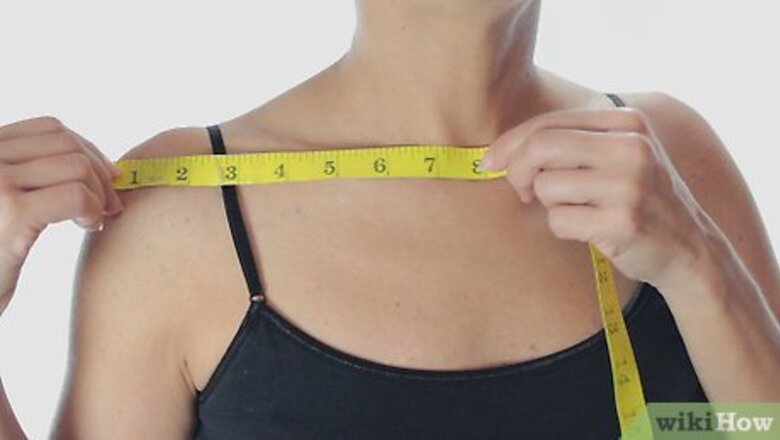
views
Drafting a Pattern Using Your Measurements
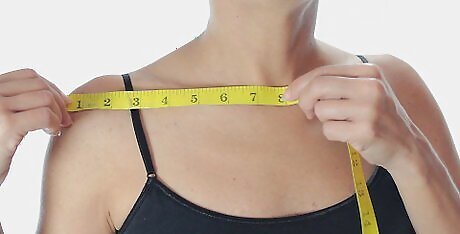
Take your measurements. You have to take accurate measurements if you’re going to sew something. In order to create accurate patterns that fit you well, you'll need to use a soft measuring tape and write down the following measurements: Bust for women's clothing: Wrap the tape around the widest part of your bust. Waist: Measure around the narrowest part of your natural waist. Height for dresses: Stand straight against a wall and have someone measure from the top of your head to the base of your feet. Neck for men's shirts: Wrap the tape around the neck where the collar of the shirt will sit. Hips: Wrap the tape around the widest part of your hips. Back length and width: Measure from the neck to the waist to find the length and measure across the widest part of your back to find the width. Chest for men or women's clothing: Measure across the widest part of your chest above your bust. Sleeve length: Hold the tape from the shoulder down the arm as long as you want the sleeve to be. Shoulder length: Measure from the neck to the edge of the shoulder. Upper arm width: Wrap your measuring tape around the thickest part of your arm near the armpit.
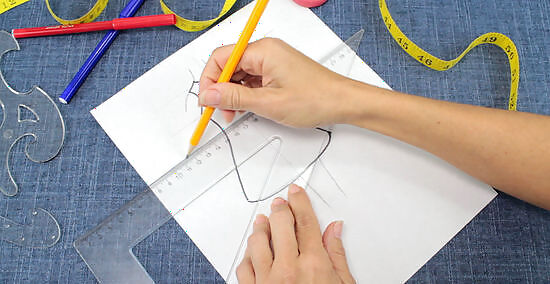
Sketch a design of the garment you want to make. Decide if you're making a skirt, pants, or top and whether or not it will have sleeves. Then, draw a rough design of how the garment should look. This will help you determine how to divide the garment into pieces so you know how many separate pattern pieces you'll need to make. For example, if you're making a simple slip dress, you might need 1 front piece, 1 back piece, and a sleeve strap pattern.
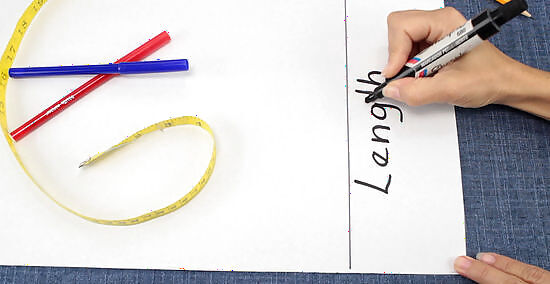
Lay a sheet of paper flat and plot the length of your pattern. Place a large piece of pattern or brown postal paper on a flat work surface and ensure that 1 side of the paper is perfectly straight. Then, place a ruler 2 inches (5.1 cm) from the top of the paper and measure from that point down as long as you want the garment to be. Tip: To determine how long to make a dress, look at your height measurement and decide how much of your body you want the dress to cover. If you're making a shirt or top, refer to your back length measurement and where you want the shirt to fall in relation to your waist. For example, if you're 6 ft (1.8 m) tall, make the dress 37 inches (94 cm) long for a mini-dress, 40 inches (101.6 cm) for a knee-length dress, or 61 inches (154.9 cm) for a floor-length dress. The straight edge of the paper will become the center front (CF) of the pattern. Make your length mark along this edge.
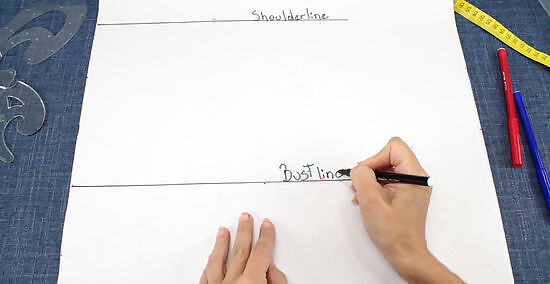
Draw horizontal lines to mark the shoulder, bust, waist, and hip line. Place a straight ruler so it's at a 90-degree angle at the top of the line you just drew for the center front. Draw this top horizontal line, which will be your shoulder line. Then, bring the ruler down to make the horizontal bust line. Move the ruler down again to draw the horizontal waistline. The bottom of your shirt will be the hip line. Refer to the measurements you took to determine where to place the ruler for the shoulder line, bust line, waistline, and hip line.
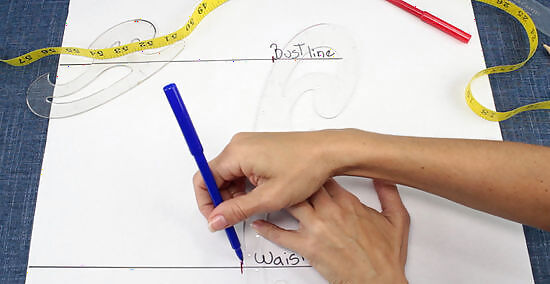
Draw a line connecting the bust or chest, waist, and hip measurements. Look at your measurements and make a dot on the bust line that's 1/4 as long as the distance of your measurement. Do this for the waist and hips too. Then, use a pencil and curved ruler to sketch a line that connects the dots on the bust or chest line, the waistline, and the hip line. For example, if your bust measurement was 40 inches (100 cm), divide it by 4 to get 10 inches (25 cm). Make a mark that's 10 inches (25 cm) from the edge on the bust line. This will make 1 edge of your center pattern piece.
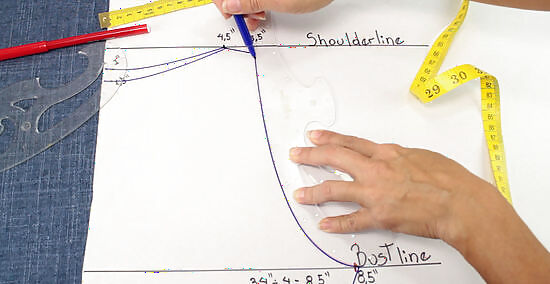
Draw the neckline and shoulder. Use a curved ruler to draw your neckline from the top of the shoulder line to the center front line. You can make the neckline as low or high as you like, keeping in mind that the back neckline is usually higher than the front neckline. Then, leave space for the armhole and draw a curved line from the shoulder down above the bust line. To make the shoulder sit naturally, give the shoulder a slightly downward slope.
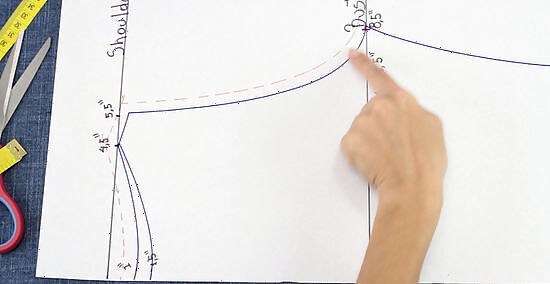
Add a seam allowance around the curved edges of your piece. Use a ruler or seam allowance ruler to draw a line that's parallel to your pattern outline. Add ⁄2 inch (1.3 cm) allowance. You can add a ⁄2 inch (1.3 cm) larger allowance along the bottom line. This can make it easier to hem your garment. For example, if your pattern piece is 61 inches (154.9 cm) long, make the seam allowance line 61 ⁄2 inches (156.2 cm) long.
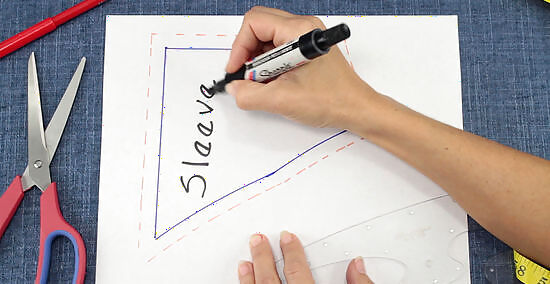
Create a sleeve pattern if you want a dress or shirt to have sleeves. Refer to the measurements you took for sleeve length and upper arm width and decide what style of sleeves you want for the garment. Draw your sleeve pattern on the fold. For example, the length of the sleeve might be 5 inches (13 cm) long and you'll use the arm width measurement of 12 inches (30 cm) to determine how wide to make the sleeve.
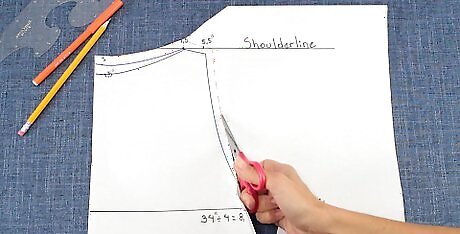
Cut out and label the pattern pieces. Lay another sheet of pattern paper under your traced pattern. Pin the papers together and use scissors to cut through both layers along the seam allowance line. The bottom layer will become the back pattern piece. Take care not to cut the curved neckline so you can adjust the front and back pieces as you like.Tip: The number of pattern pieces you need to make will depend on the garment you're making. For example, if you're making a plain T-shirt, you might only need 4 pattern pieces, 1 for the front, 1 for the back, 1 for the sleeves, and 1 for the collar. A full skirt that flares out may need 6 identical pieces that are attached with a waistline piece. For example, you might want to cut the front neckline low while leaving the back piece's neckline high. Label each pattern piece you make so it's easy to keep track of them.
Making Templates from Clothing
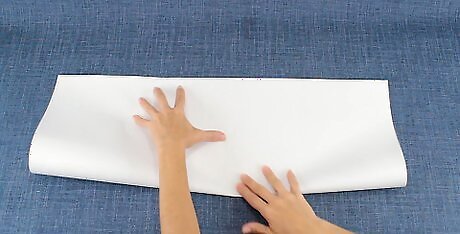
Cut out a piece of pattern paper and fold it in 1/2 vertically. Cut a piece of paper that's larger than your garment and fold it. Then, lay the paper on a flat work surface instead of on carpet or a rug. If you don't have pattern paper, you could use brown postal wrapping paper. You could work on a stiff corkboard if you'd like to be able to pin the garment onto the paper as you work.
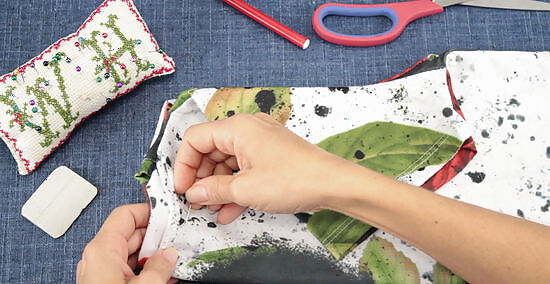
Fold your garment in 1/2 vertically and pin along the seams. Since most pieces of clothing are cut on the fold, you'll need to fold your item in 1/2 lengthwise so the seam is visible in the center. Once you've lined up the garment so the edges and seams match, insert pins along the seams for the panel you folded.Tip: Ensure that the item you're copying fits you well. This will make it easier to create a pattern that fits you without having to adjust it very much. You'll be tracing each individual piece so only pin the panel that's folded in 1/2 right now.
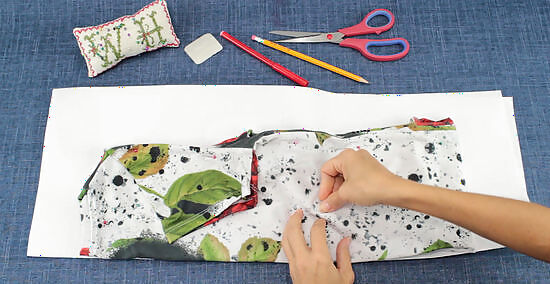
Lay the item on the paper and pin it in place. Line up the folded edge of your garment with the folded edge of the paper. Insert sewing pins about every 3 to 4 inches (7.6 to 10.2 cm) along the edge so the garment doesn't slide off of the paper as you're tracing it. If your garment has sleeves, fold them over the main panel of the item so they don't stick out. This technique can be used on any garment, but it does work best on simple garments stitched together from basic shapes, such as a tunic, instead of a lined dress with darts, for instance.
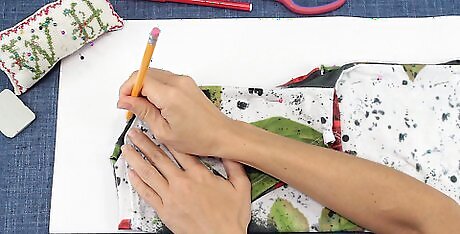
Trace around the folded piece of the garment. Use a pencil, chalk, or tracing wheel to trace around the seams of the panel that you folded and pinned. Don't try to trace every panel of the item at this point. If you can't trace around a seam because there's another panel of fabric connected to it, you'll need to fold up the excess fabric or use the tracing wheel. Roll the tracing wheel directly over the garment since the wheel won't damage the fabric.
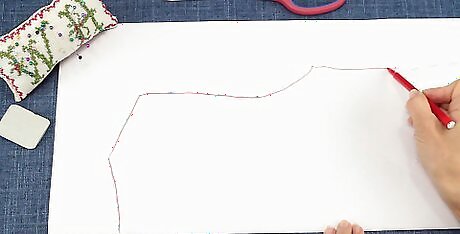
Remove the item and draw a bold line over the one you traced. Take each of the pins out so you can lift away the garment. Use a pen to draw over the traced line so it's easier to see. Now you can label the pattern piece. For example, write on the piece, "center front piece." You can also mark any lines that are specific to that piece. For example, draw a curved line to indicate where the neckline meets the fold.
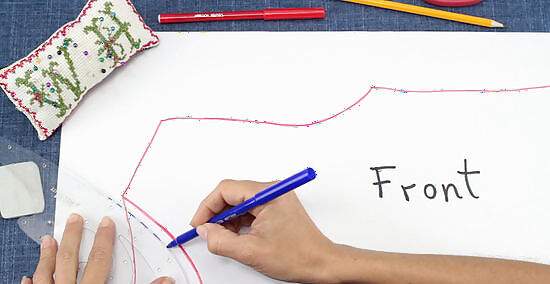
Draw a seam allowance around the pattern piece. Use a straight or curved tailor's ruler to make a parallel line ⁄2 inch (1.3 cm) away from the edge of the pattern line you just drew. This will be the seam allowance. Most commercial patterns use a seam allowance of ⁄8 inch (1.6 cm) so use whichever measurement you prefer.
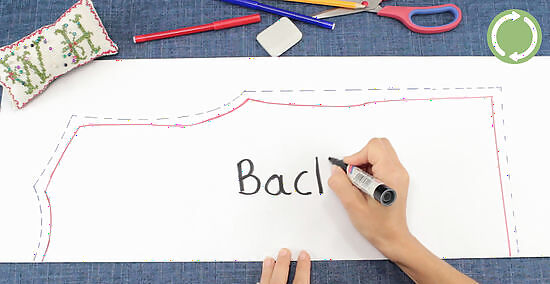
Draw a pattern piece for each section of your garment. Roll out another piece of paper and repeat the process for each portion of the garment that you'll need to sew together. Make a note on the pattern piece if you'd like to add a closure, such as a snap, button, or zipper.Tip: Remember to label each piece of your pattern. This will make it easier to use the pattern later once you've forgotten which pieces are which! For example, if you're sewing a basic shirt, you might have a front center piece, back center piece, sleeve piece, and neckline.
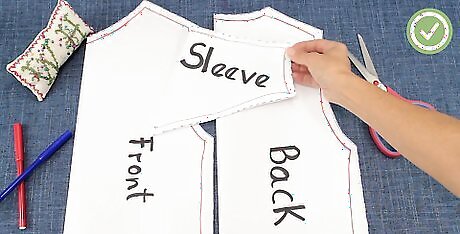
Cut out each pattern piece. Use a sharp pair of scissors to cut out each of the pieces. Remember to keep the paper folded as needed so you don't accidentally cut your pattern pieces in 1/2. If you prefer, place a cutting mat under the pieces and use a rotary cutter instead of scissors.




















Comments
0 comment